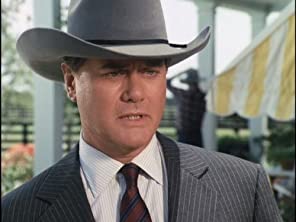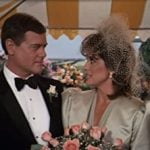
S9E02

S9E02
Table of Contents
Toggle
Who was Larry Hagman before he became J.R.? And how did this role come to define him? In this article, we will explore the life and career of Larry Hagman, from his early days in Hollywood to his rise to fame as one of television’s most beloved villains. We will examine how his love for playing complex characters paved the way for his unforgettable performance as J.R., and how this role forever changed both his career and pop culture as we know it today.

Larry Hagman was born on September 21, 1931, in Fort Worth to Mary Martin, who would become one of the most popular musical theater actresses of her time. Despite having a famous mother, Hagman had a difficult childhood. His father was an alcoholic and his parents divorced when he was five years old.
Despite his childhood struggles, Hagman found success as an actor in the 1960s with his role as astronaut Tony Nelson in I Dream of Jeannie. He spent five years playing the lovable hero before transitioning to the villainous role of J.R. Ewing on Dallas. According to him, playing bad guys was much more fun than playing good guys because there were fewer restrictions on how he could portray them.
Aside from acting, Hagman was known for his personal eccentricities. He carried a cane and wore a feather-topped 10-gallon hat whenever he could. He also drove around in a bread truck that he had converted into a camper and decorated with colorful murals depicting scenes from Texas history. These quirks certainly added to his charm as an actor and made him all the more memorable to audiences around the world.

Larry Hagman relished portraying despicable characters and found immense joy in playing the villain, a trait that was evident throughout his career, including his iconic performance on Dallas. He believed that these evil characters had more depth and complexity than the typical hero role. Hagman’s acting technique involved finding redeeming qualities in these dark characters to make them more human and relatable to the audience.
Hagman’s love for playing villains was not unique in Hollywood, as many actors have found success in similar roles. However, his portrayal of J.R. Ewing on Dallas solidified him as one of the greatest TV villains of all time. The character of J.R. was loathed by fans but also loved for his cunning wit and manipulative ways.
Despite the negative reception towards J.R., Hagman never tired of playing this infamous role, even after 14 seasons on air. He understood that it was important to keep the audience engaged and entertained with his performance as this villainous oil magnate. His dedication to bringing life to such a complex character made him an unforgettable icon in television history.
As Larry Hagman continued to thrill audiences with his performances as villains, he would soon find himself taking on what would become known as his defining role: J.R. Ewing on Dallas.

The show that would soon become a cultural phenomenon was about to introduce a character so iconic, audiences across the globe would come to love and hate him in equal measure. Dallas premiered in March 1978 and immediately captured viewers with its portrayal of the Ewing family and their oil industry empire. The show’s success was due in large part to Larry Hagman’s portrayal of J.R. Ewing.
J.R. Ewing was the ultimate villain, but he was also a product of his environment and family dynamics. He embodied the greed and excess of 80s culture, which made him relatable to audiences around the world. Larry Hagman embraced the role wholeheartedly, bringing a level of campy perfection that made J.R. both despicable and lovable at the same time.
Dallas became more than just a nighttime soap opera; it became a cultural touchstone for an entire generation. And at its center was Larry Hagman as J.R. Ewing, who left an indelible mark on pop culture that still resonates today.

The impact of Dallas and its iconic villain, J.R. Ewing, continues to resonate in pop culture today, cementing Larry Hagman’s legacy as a beloved and unforgettable actor. The show was a cultural phenomenon that captured the attention of millions of viewers during its original run from 1978-1991, with Hagman’s portrayal of the conniving oil tycoon earning him critical acclaim and fan adoration. Even after his death in 2012, the influence and lasting impact of both Dallas and J.R. Ewing are still felt in popular media.
One way in which Dallas has influenced pop culture is through its use of cliffhangers at the end of each episode. This became a signature element of the show that kept audiences on edge and coming back for more each week. Many shows since then have tried to replicate this formula with varying degrees of success, but none have quite matched the level of suspense that Dallas achieved. Additionally, J.R.’s character has become an archetype for villainous businessmen in film and television, inspiring countless imitators over the years.
Beyond these specific examples, however, Dallas’s cultural significance lies in how it helped define what we now think of as “appointment viewing.” The show was one of the first true watercooler shows – something that everyone watched and talked about around the office or at school the next day. It created a sense of community among viewers who were all experiencing it together every week. This kind of shared experience is harder to come by nowadays, with so many options available for streaming on-demand content.
Larry Hagman’s legacy as an actor is firmly tied to his iconic role as J.R. Ewing on Dallas – one that will undoubtedly continue to be remembered for generations to come. However, his life was much more than just one part he played on television. In exploring his background and personal struggles, we can gain a deeper appreciation for the man behind the character.

Despite being well-known for portraying J.R. Ewing, Hagman had more than 80 TV and 20 film credits over a career spanning 50+ years. He also played notable roles such as H.L. Hunt/Clint Murchison in Nixon and Gov. Fred Picker in Primary Colors.
Hagman’s personal struggles with alcoholism were well-documented, including pouring bourbon on his cornflakes and sometimes struggling to remember lines due to drinking. However, he also celebrated achievements such as undergoing a liver transplant after being diagnosed with cirrhosis of the liver in 1992. His dedication to acting was evident through his return to Dallas in 2012 to film season one and part of season two of TNT’s Dallas reboot despite announcing a second bout with cancer the year before.
Since Hagman’s death from complications of throat cancer at age 81 in Dallas with family by his side, fans have continued to pay tribute to him through social media posts and memorials placed at Southfork Ranch where the show was filmed. The city of Dallas honored him by naming a street after him near Southfork Ranch and dedicating a statue depicting J.R.’s famous “Who shot J.R.” cliffhanger moment in downtown Dallas. While J.R. Ewing will always be an iconic character associated with Larry Hagman, his legacy extends far beyond that role through his extensive contributions to television and film during his career spanned over half a century.

In conclusion, Larry Hagman was a larger-than-life personality who will always be remembered for his iconic portrayal of J.R. Ewing on Dallas. He brought a unique Texan charm to the role, and his character became synonymous with greed and ruthless ambition. Despite facing personal struggles throughout his life, Hagman remained a beloved figure in Hollywood until his death in 2012.
Hagman’s legacy lives on through J.R. Ewing, who remains an enduring cultural icon that has spawned numerous imitations over the years. The impact of Hagman’s performance cannot be overstated, as he helped redefine what it meant to be a villain in American popular culture. His contributions to entertainment will never be forgotten, and he will always be remembered as one of the greats. Larry Hagman may have passed away, but his spirit lives on through the characters he created and the memories he left behind.
A: J.R. Ewing was a fictional character on the television series Dallas, played by actor Larry Hagman. He was an oil baron and central to many of the show’s storylines.
A: Ewing Private Reserve is the name of J.R.’s trademark bourbon on the television series Dallas. It is a fictional brand.
A: J.R. Ewing was played by the late actor Larry Hagman on the television series Dallas.
A: Dallas was a popular television series that aired from 1978 to 1991. It followed the lives of the wealthy Ewing family in Dallas, Texas.
A: Sue Ellen was J.R. Ewing’s wife on the television series Dallas, played by actress Linda Gray.
A: John Ross was J.R. Ewing’s son on the television series Dallas.
A: J.R. Ewing did not appear in a movie, but the character was featured in several made-for-television films based on the Dallas series.
A: Christopher is J.R. Ewing’s nephew on the television series Dallas.
Click on a star to rate it!
Average rating 0 / 5. Vote count: 0
No votes so far! Be the first to rate this post.
We are sorry that this post was not useful for you!
Let us improve this post!
Tell us how we can improve this post?
Before retirement, Dora was the editor and publisher of various online magazines. For example, she edited and published GEnie Lamp – an online magazine for General Electric’s Information Service (GEIS) – and the BBS Magazine, TeleTalk Online.
Now retired, Dora and her husband, Mike, enjoy RV traveling, camping, and meeting fellow campers.